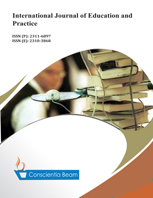Mathematics education for students with intellectual disabilities: A study on thematic books utilization in special schools
DOI:
https://doi.org/10.18488/61.v12i3.3816Abstract
Books are a significant source of mathematics learning for children with intellectual disabilities. A book's design and content must describe the learning requirements. This study seeks to discover how thematic books, specifically, are used in the learning of mathematics for students with intellectual disabilities. This study uses quantitative and qualitative methodologies with an explanatory sequential design. The content study of ten textbooks for high school students with intellectual impairments provides an overview of the applicability of the competencies contained in the curriculum. The number of pages in the textbooks ranges from four to 23, with practice questions dominating the majority of learning material about natural numbers with mixed computational kinds, and the majority of problems are short entries. The findings of this study show that teachers only use books occasionally, which is valuable data that opens up opportunities to design specific textbooks for mathematics learning. Their use is through adaptation and modification processes, but teachers use other sources for learning (e.g., designing their own and searching the internet), and computing material and the use of money are mostly taught to students through short answer questions. The conclusions of this study provide significant information for designers of future mathematics learning books.





